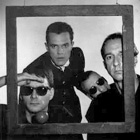Review
Kevin Eden
Everybody Loves a History
Kevin Eden decided to write Everybody Loves a History after noticing that much of the published information about Wire was inaccurate, and the simple fact that no biography existed. The aim was to present the band's history to 1985, but as time and Wire progressed so did the book and it covers the band and solo projects until the date of publication: mid 1991.
The author's narrative is kept to a minimum; interviews with Wire and various collaborators make up the bulk of the text, giving the reader a useful first-hand account of the band. It also enables Wire to explain itself, particularly various misinterpretations that came about due to the group's elusiveness and dislike of the press. Each member offers a personal history up to the time they became involved with Wire and each phase of the band's history is explored.
The largest section covers the formation of the band, each of the '70s EMI albums and an explanation of what the Jeanette Cochrane and Document and Eyewitness shows were all about. In each case lyrics are deconstructed and stories told. For example, 106 Beats That's odd chord structure is apparently based on a sequence of letters from train stations on a very slow journey Colin Newman took.
Solo works are explained and detailed including Colin's solo albums, Dome's anarchic performances, Bruce's dance commissions, Graham's He Said project, and Robert's drumming for Fad Gadget. The Dome section is particularly interesting, giving one an insight into alternative methods of studio technique and production. It also includes photographs of installation work such as MU:ZE:UM:TRACES, which were as significant as recorded output.
Two final sections bring us to the end of the book. 'It's not the past again' deals with Wire's reformation in 1984 and its subsequent musical rebirth via Drill and A Serious of Snakes. The interpretations of the A Bell is a Cup... lyrics bring a new level to an album of fairly abstract narratives. 'Silence please! Poets at work' ends the Wire story with Manscape, detailing the band's technological revolution.
Due to the fact this book was published in 1991 it stops just as Wir arose so there are no comments on what that project achieved in the eyes of each member. (Nor are there any comments on other work since.) Despite this, it is worthwhile for anyone with a genuine interest in Wire.
Craig Grannell (1998)
